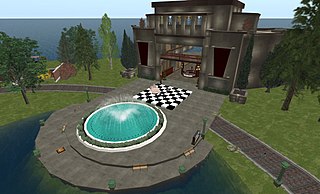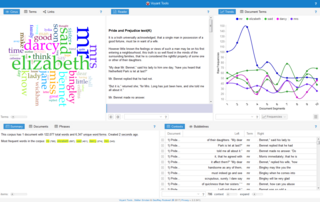Related Research Articles

Digitization is the process of converting information into a digital format. The result is the representation of an object, image, sound, document, or signal obtained by generating a series of numbers that describe a discrete set of points or samples. The result is called digital representation or, more specifically, a digital image, for the object, and digital form, for the signal. In modern practice, the digitized data is in the form of binary numbers, which facilitates processing by digital computers and other operations, but digitizing simply means "the conversion of analog source material into a numerical format"; the decimal or any other number system can be used instead.

A curator is a manager or overseer. When working with cultural organizations, a curator is typically a "collections curator" or an "exhibitions curator", and has multifaceted tasks dependent on the particular institution and its mission. The term "curator" may designate the head of any given division, not limited to museums. Curator roles include "community curators", "literary curators", "digital curators" and "biocurators".
Formerly known as The United Kingdom Office for Library and Information Networking, UKOLN was a centre of expertise in digital information management, providing advice and services to the library, information, education and cultural heritage communities. UKOLN was based at the University of Bath and was funded through a mixture of core and project grants. Latterly it received its core funding solely from JISC, but had received core grants previously from the Museums, Libraries and Archives Council and the British Library.
In library and archival science, digital preservation is a formal endeavor to ensure that digital information of continuing value remains accessible and usable. It involves planning, resource allocation, and application of preservation methods and technologies, and it combines policies, strategies and actions to ensure access to reformatted and "born-digital" content, regardless of the challenges of media failure and technological change. The goal of digital preservation is the accurate rendering of authenticated content over time. The Association for Library Collections and Technical Services Preservation and Reformatting Section of the American Library Association, defined digital preservation as combination of "policies, strategies and actions that ensure access to digital content over time." According to the Harrod's Librarian Glossary, digital preservation is the method of keeping digital material alive so that they remain usable as technological advances render original hardware and software specification obsolete.

A virtual museum is a digital entity that draws on the characteristics of a museum, in order to complement, enhance, or augment the museum experience through personalization, interactivity, and richness of content. Virtual museums can perform as the digital footprint of a physical museum, or can act independently, while maintaining the authoritative status as bestowed by the International Council of Museums (ICOM) in its definition of a museum. In tandem with the ICOM mission of a physical museum, the virtual museum is also committed to public access; to both the knowledge systems embedded in the collections and the systematic, and coherent organization of their display, as well as to their long-term preservation.
The Arts and Humanities Data Service (AHDS) was a United Kingdom national service aiding the discovery, creation and preservation of digital resources in and for research, teaching and learning in the arts and humanities. It was established in 1996 and ceased operation in 2008.

Digital humanities (DH) is an area of scholarly activity at the intersection of computing or digital technologies and the disciplines of the humanities. It includes the systematic use of digital resources in the humanities, as well as the analysis of their application. DH can be defined as new ways of doing scholarship that involve collaborative, transdisciplinary, and computationally engaged research, teaching, and publishing. It brings digital tools and methods to the study of the humanities with the recognition that the printed word is no longer the main medium for knowledge production and distribution.
The Digital Curation Centre (DCC) was established to help solve the extensive challenges of digital preservation and digital curation and to lead research, development, advice, and support services for higher education institutions in the United Kingdom.
Ronald Milne FRSE is a British librarian and administrator whose work has been particularly associated with the development of library research collections and with issues of digitisation of library materials. In 2006 he became a Fellow of The Royal Society of Edinburgh.
Digital curation is the selection, preservation, maintenance, collection, and archiving of digital assets. Digital curation establishes, maintains, and adds value to repositories of digital data for present and future use. This is often accomplished by archivists, librarians, scientists, historians, and scholars. Enterprises are starting to use digital curation to improve the quality of information and data within their operational and strategic processes. Successful digital curation will mitigate digital obsolescence, keeping the information accessible to users indefinitely. Digital curation includes digital asset management, data curation, digital preservation, and electronic records management.

Europeana is a web portal created by the European Union containing digitised cultural heritage collections of more than 3,000 institutions across Europe. It includes records of over 50 million cultural and scientific artefacts, brought together on a single platform and presented in a variety of ways relevant to modern users. The prototype for Europeana was the European Digital Library Network (EDLnet), launched in 2008.

The Consortium of European Taxonomic Facilities (CETAF) is a taxonomic research network formed by scientific institutions in Europe. It was formed in December 1996 by ten of the largest European natural history museums and botanical gardens to be a voice for taxonomy and systematic biology in Europe, to promote scientific research and access to European natural history collections, and to exploit European funding opportunities. Since then, CETAF has served as a meeting point for major European natural history museums and botanical gardens, and has initiated and played an important role in a number of projects.
Data curation is the organization and integration of data collected from various sources. It involves annotation, publication and presentation of the data so that the value of the data is maintained over time, and the data remains available for reuse and preservation. Data curation includes "all the processes needed for principled and controlled data creation, maintenance, and management, together with the capacity to add value to data". In science, data curation may indicate the process of extraction of important information from scientific texts, such as research articles by experts, to be converted into an electronic format, such as an entry of a biological database.

Trove is an Australian online library database owned by the National Library of Australia in which it holds partnerships with source providers National and State Libraries Australia, an aggregator and service which includes full text documents, digital images, bibliographic and holdings data of items which are not available digitally, and a free faceted-search engine as a discovery tool.
Seamus Ross is a digital humanities and digital curation academic and researcher based in Canada.
Digital heritage is the use of digital media in the service of understanding and preserving cultural or natural heritage.
Elizabeth Yakel is an archivist, researcher, and educator in information science. Yakel is known for work advancing archival practice, the use of primary sources in archives education, studies of data reuse practices, and digital curation. Yakel is the senior associate dean for academic affairs and a professor at the University of Michigan School of Information, where she has been on the faculty since 2000. She is the former coordinator of the Preservation of Information specialization in the Master of Science in Information program and teaches in the Archives and Record Management area. She specializes in digital archives and digital preservation and has developed five such graduate level courses at UM, including "Economics of Sustainable Digital Information" and "Practical Engagement Workshop in Digital Preservation."
The Television New Zealand Archive collection contains over 600,000 hours of television spanning almost 55 years of New Zealand's public television history. It includes New Zealand content such as documentaries, dramas, sports programmes and every TVNZ news broadcast from December 1986 to 2014. The archive only holds titles that have previously been broadcast – raw footage is not included. The archive also includes thousands of photographic stills. Both TVNZ and the Ministry for Culture and Heritage hold a list of the titles held in the TVNZ Archive collection. This has subsequently been released under the Official Information Act. The Ministry considers the majority of titles to be of high heritage and cultural value and the Minister of Broadcasting Craig Foss stated it was a "unique record of life in New Zealand". The contents of the collection are subject to the Public Records Act 2005. In 2014 the Ministry for Culture and Heritage, on behalf of the Crown, became the guardian of the archive. The physical collection is located in the Wellington region, in the former TVNZ Avalon facility now owned by the Department of Internal Affairs.

Lorna M. Hughes has been Professor in Digital Humanities at the University of Glasgow since 2015. From 2016 to 2019, she oversaw the redevelopment of the Information Studies subject area The re-launch was marked by an international symposium at the University of Glasgow in 2017.
Unlocking Film Heritage (UFH) was one of the biggest film digitisation projects ever undertaken and it encompassed the BFI National Archive together with national and regional audiovisual archival institutions in United Kingdom. Between 2013–2017 around 10,000 titles, capturing 120 years of Great Britain on film, were digitised and made free-to-access in a variety of ways. Many archival clips can be watched for free online via BFI Player.
References
- ↑ "C3D-COFORM (Tools and Expertise for 3D Collection Formation)". website. Retrieved 25 September 2017.
- ↑ "C3D-COFORM (Tools and Expertise for 3D Collection Formation)". CORDIS Website. Retrieved 25 September 2017.
- ↑ "SHAMAN - Sustaining Heritage Access through Multivalent ArchiviNg". CORDIS Website. Retrieved 25 September 2017.
- ↑ "DigiCULT Project". website. Retrieved 25 September 2017.
- ↑ "CASPAR Digital Preservation Project". CORDIS Website. Retrieved 25 September 2017.
- ↑ "DELOS (Digital Library Network of Excellence)". CORDIS Website. Retrieved 25 September 2017.
- ↑ "Planets (Preservation and Long-term Access to our Cultural and Scientific Heritage)". CORDIS Website. Retrieved 25 September 2017.
- ↑ "ERPANET". website. Retrieved 25 September 2017.
- ↑ "ERPANET". CORDIS website. Retrieved 25 September 2017.
- ↑ "Digital Preservation Europe". CORDIS website. Retrieved 25 September 2017.
- ↑ "Digiman Animations on Digital Preservation". animations. Retrieved 25 September 2017.
- ↑ "UK Digital Curation Centre". website. Retrieved 25 September 2017.
- ↑ Seamus Ross, Michael Moss and Lesley Richmond, 1998, "Planning and Designing a Programme of Digital Preservation Studies," in Electronic Access: Archives in the New Millennium: conference proceedings, 3–4 June 1998, (London: Public Record Office, Kew), ( ISBN 978-1873162743), pp.102-110
- ↑ "Digital Media and Information Studies". website. Retrieved 19 April 2019.
